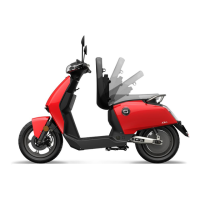
Do you have a question about the Super SOCO CUX 2019 and is the answer not in the manual?
| Motor Type | Brushless DC Motor |
|---|---|
| Range | 75 km |
| Max Speed | 45 km/h |
| Brakes (Front) | Disc |
| Brakes (Rear) | Disc |
| Tires (Front) | 90/90-12 |
| Tires (Rear) | 90/90-12 |
| Max Load | 150 kg |
| Wheel Size | 12 inches |
| Suspension (Front) | Telescopic Fork |
| Motor Power | 1.3 kW |
| Battery Capacity | 30 Ah |
| Charging Time | 7 h |
Ensure qualified assembly, necessary training, and adherence to traffic laws before riding.
Always wear appropriate safety gear and follow safe riding practices, avoiding distractions.
Ride considerately, handle surfaces carefully, perform pre-ride checks, and report unusual noises.
Never ride impaired, use the side stand safely, and ensure all servicing is done by an authorized dealer.
Displays current speed, time, or error codes on the instrument panel.
Shows selected riding mode (Eco, Normal, Sport) and vehicle mileage.
Indicates battery charge level and data connection status.
Explains various warning and status lights like indicators, errors, and beam status.
Details horn, indicators, high/dipped beam, and cruise control functions on the left handlebar.
Explains the function of the SET button on the right handlebar for instrument display changes.
Details gear change, hazard flasher, and parking button functions on the right handlebar.
Guides through the process of starting the motorcycle, including key fob, side stand, and park mode.
Explains how to use the key fob for unlocking, powering on/off, and opening the saddle.
Details the ignition switch positions for starting, powering, and steering lock.
Explains the function of the safety switch located under the seat for powering the motorcycle.
Check tyre pressure, tread, wear, brake operation, and fluid levels for safety.
Ensure smooth steering, sufficient battery charge, and smooth throttle operation.
Verify all lights, horn, and ensure no error messages are displayed.
Always ensure you are wearing a helmet and appropriate motorcycle clothing.
Details storage options and maximum loading capacity, including rider and passenger.
Ensure full charge for the first 3 times and at least every 2 months.
Understand charger operation, charge times, consequences of low battery, and normal depletion.
Factors affecting range and the importance of charging after each ride.
Proper procedure for storing the motorcycle and battery to prevent damage.
Step-by-step charging guide, charger safety, and critical warnings about battery use.
Use only original chargers and cables; ensure proper connection sequence to outlets.
Ensure proper domestic wiring, safe battery storage, and emergency procedures for accidents.
Clean regularly with designed products; avoid high-pressure cleaners to prevent damage.
Maintain correct tyre pressure (36 PSI front/rear) for optimal range and handling.
Refer mechanical issues to a dealer; try power cycling for error messages.
Diagnose and resolve issues like dead battery, safety switch, parking mode, or brake engagement.
Address issues like low tyre pressure, overloading, battery age, or connection problems.
Troubleshoot controller communication failures, suspended operations, or specific error codes.
Resolve errors related to charge overcurrent/overvoltage, battery temperature, or connection issues.
Details essential checks for every service, including battery, tyres, brakes, and fasteners.
Outlines required inspections at specific mileage intervals or timeframes.